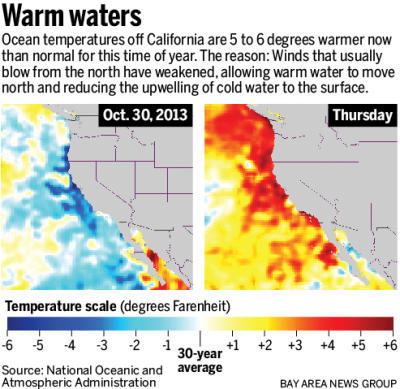- California Enduro Series Announces 2024 Schedule - 11/19/2023
- ASHLAND MOUNTAIN CHALLENGE 2023 – CES RACE REPORT - 10/04/2023
- China Peak Enduro 2023 – CES Race Report - 09/04/2023
Climate Nexus explains the connection between climate change and atmospheric rivers in California
With the drought-causing high-pressure zone dubbed the “Ridiculously Resilient Ridge” pushed aside for now, a powerful storm associated with what are called atmospheric rivers recently drenched the California Bay Area. Atmospheric rivers are relatively narrow, long streams of clouds and atmospheric water vapor that are associated with major storms in the Pacific. These streams, many of which originate from Hawaii or beyond and are known as the “Pineapple Express” bring moisture from the Tropics into the West Coast. “It’s essentially a fire hose of water brought up from the tropics that comes up and crashes into the West Coast,” said Michael Dettinger, an atmospheric scientist with the Scripps Institution of Oceanography in La Jolla.
Atmospheric river storms are responsible for 30-50 percent of all the precipitation in California and are also responsible for over 80 percent of major flooding events. Climate research indicates that the impacts of these storms are expected to escalate dramatically if carbon emissions continue along the business-as-usual path, and that atmospheric rivers may already be impacted by current warming:
- As the world heats up and more heat is carried in the atmosphere as water vapor, heavy precipitation events are becoming more intense.
- Climate models project that atmospheric river storms in California will become more frequent and intense in the future, which means it is likely that the current storm is a taste of what’s to come.
- Surface temperatures off the coast of California during this particular storm are much warmer than usual, helping to pump even more moisture into the storm.
A Charged Atmosphere
In the past half-century, climate change has charged the atmosphere with more water vapor, fueling extreme precipitation and loading storms of all types with additional moisture that ends up as rain and snowfall. The fingerprint of global warming has been firmly documented in the shift toward extreme precipitation already observed in the northern hemisphere. In the particular case of atmospheric river storms in California other factors, especially wind strength, can also influence how much rain is wrung out of the storm. We are still learning how climate change may be affecting those factors.
The atmospheric rivers that arrive in California collect moisture over a large swathe of the tropics, including the extra water vapor added to the atmosphere by global warming. This water is then delivered to California through the end of the storm hose, creating torrential rain and floods.
Since 1950, atmospheric river storms have been responsible for 81 percent of the most well-documented levee breaks in California’s Central Valley and 80 percent of the flooding in California rivers. In delta areas, such as the San Francisco Bay, climate change puts the region in double jeopardy. Climate change contributes to sea level rise, which adds to the flood levels pushed up by the atmospheric river storms. Since 1854 sea levels have rise about a foot in the San Francisco Bay.
A Warmer Ocean
Temperatures off the California coast are currently 5 to 6°F warmer than historic averages for this time of year—among the warmest autumn conditions of any time in the past 30 years—which could intensity the current atmospheric river storm. While connections between global warming and the current, unusually warm waters off the California coast are not fully understood, the warm coastal conditions are known to be linked to rare changes in wind patterns. Winds that normally blow from the north, trapping warm water closer to the equator, have slackened since the summer, allowing the warm water to move north.
And a More Intense Future
Looking ahead, the computer models predict that climate change will cause the very worst atmospheric river storms hitting California to become much more frequent and larger. One model illustrating the impacts of a large-scale atmospheric storm, similar in scope to the infamous river storm of 1861 that turned the Central Valley into an inland lake, found that such an event would inflict over $400 billion in damages in modern day California.
For more information or to be connected with experts on the link between climate change and atmospheric rivers in California, contact Paige Knappenberger at pknappenberger@climatenexus.
Climate Nexus is a strategic communications group dedicating to highlighting the wide-ranging impacts of climate change and clean energy solutions in the U.S.















